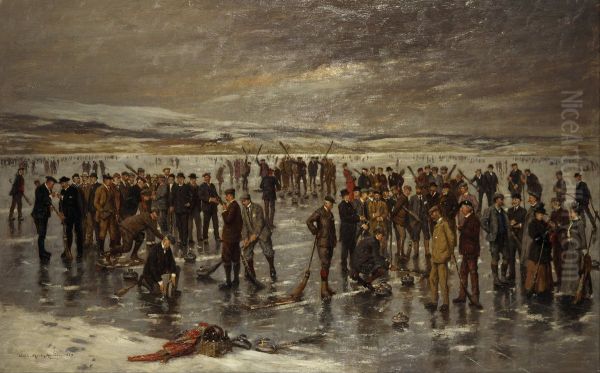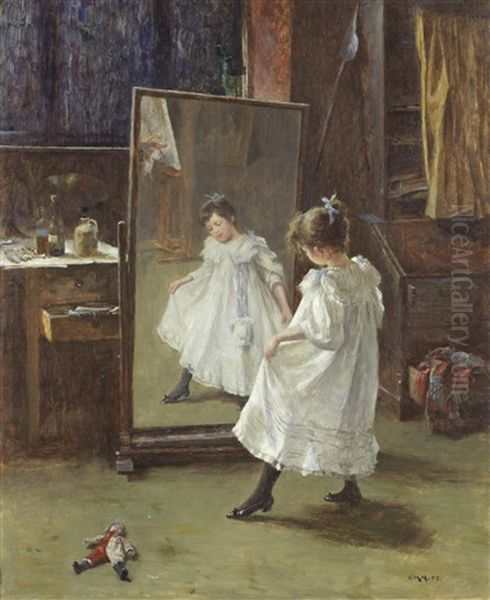Martin Hardie (1875-1952) stands as a significant, if sometimes understated, figure in early 20th-century British art. He was a man of dual talents, excelling both as a practicing artist, particularly in the demanding medium of etching and the delicate art of watercolour, and as an influential museum curator and scholar. His career at the Victoria and Albert Museum placed him at the heart of print connoisseurship in Britain, while his own artistic output contributed to the ongoing traditions of British landscape and topographical art. His life and work offer a fascinating insight into the art world of his time, bridging the gap between artistic creation and scholarly preservation.
Early Life and Artistic Awakening
Born in the St Pancras district of London in 1875, Martin Hardie's early life set him on a path towards academic and artistic pursuits. He received a sound education, culminating in his studies at Trinity College, Cambridge. While Cambridge provided a strong intellectual foundation, his artistic inclinations soon led him to the Royal College of Art in South Kensington. It was here that his passion for printmaking, especially etching, was truly ignited.
A pivotal influence during this formative period was his tutelage under Sir Frank Short (1857-1945). Short was a towering figure in the British Etching Revival, a renowned etcher and engraver in his own right, and an inspiring teacher who headed the engraving school at the Royal College of Art. Under Short's guidance, Hardie mastered the intricate techniques of etching and drypoint, developing a keen eye for line, tone, and composition. This training was crucial, instilling in him not only technical proficiency but also a deep appreciation for the history and aesthetics of printmaking, a field that would define much of his professional life. Other artists active during this revival, whose work Hardie would have known, included James McNeill Whistler, Seymour Haden, William Strang, Muirhead Bone, and D.Y. Cameron, all of whom contributed to the renewed interest in original printmaking.
The Etcher's Eye: Capturing Landscape and Light

As an etcher, Martin Hardie was prolific, producing over two hundred plates during his career. His work predominantly focused on landscapes, architectural subjects, and coastal scenes, often imbued with a subtle, atmospheric quality. He was drawn to the picturesque, finding inspiration in the British countryside, as well as in his travels further afield. One of his noted works, "A Brittany Landscape," exemplifies his ability to capture the essence of a place with an economy of line and a sensitive rendering of light and shadow.
Hardie's etchings are characterized by their technical assurance and understated elegance. He was not an artist given to grand, dramatic statements, but rather to the quiet observation of a scene, translated through the precise and expressive medium of the etched line. His approach was in keeping with the traditions of British topographical art, yet his work possessed a modern sensibility in its clarity and directness. His prints found appreciation among collectors and his peers, contributing to the vibrant printmaking scene of the early twentieth century, which also saw artists like Edmund Blampied and Gerald Brockhurst rise to prominence.
A Master of Watercolour
Beyond his achievements in etching, Martin Hardie was also an accomplished watercolourist. This medium, with its demands for spontaneity and transparency, complemented his meticulous work on copper plates. His watercolours often depicted similar subjects to his etchings – landscapes, townscapes, and maritime views – but allowed for a different exploration of colour, light, and atmosphere. His skill in this medium was recognized by his election to the Royal Society of Painters in Water Colours (RWS), an institution with a storied history, counting luminaries like J.M.W. Turner, John Sell Cotman, and David Cox among its past members.
Hardie's involvement with the RWS was more than just as a practicing member; he also became a historian of the society. His three-volume work, "Water-colour Painting in Britain," remains a significant contribution to the scholarship of this quintessentially British art form. This demonstrates his dual capacity to create art and to critically analyze and document its history, a rare combination that enriched both aspects of his career.
A Distinguished Curatorial Career at the Victoria and Albert Museum
Martin Hardie's profound knowledge of prints and drawings found its ideal outlet in his long and distinguished career at the Victoria and Albert Museum (V&A) in London. He joined the museum's Department of Engraving, Illustration and Design (now Prints and Drawings) and rose through the ranks, eventually serving as Keeper of Prints and Drawings from 1921 to 1935. This was a position of considerable influence, placing him in charge of one of the world's most important public collections of works on paper.

During his tenure, Hardie played a crucial role in shaping the collection, overseeing acquisitions, and promoting the study and appreciation of prints and drawings. He was responsible for cataloguing and interpreting these works for both scholars and the public. His scholarly output from this period includes important texts, such as his work on the "War Sketches" of Thomas Girtin (1775-1802), a contemporary of Turner and a master of watercolour. He also translated significant German texts on printmaking history, including works by Ludwig Friedrich Lippmann and Max Lehrs, making them accessible to an English-speaking audience and thereby broadening the understanding of European print traditions in Britain. His expertise was also sought for initiatives like the Empire Art Loan Exhibition, for which he provided advice and contributed to the catalogue.
Service in the Great War
The First World War interrupted many careers, and Martin Hardie's was no exception. He served as an officer in the British Army. His role during the conflict was unique and indicative of his observational skills and understanding of human nature. He was tasked with collecting and analyzing soldiers' letters from the front lines. This sensitive work was not merely censorship, but an effort to gauge the morale and emotional state of the troops. His reports provided valuable insights to military commanders, helping them understand the conditions and sentiments of the men under their command. This wartime experience, though far removed from the art studio or museum gallery, undoubtedly deepened his understanding of human experience, a quality that subtly informs the empathetic nature of his artistic and scholarly work.
Later Years, Recognition, and Legacy
After a dedicated career, Martin Hardie retired from the Victoria and Albert Museum in 1935. In recognition of his significant contributions to art and scholarship, he was appointed a Commander of the Order of the British Empire (CBE) in the same year. This honour underscored the high regard in which he was held within the British art establishment.
Even in retirement, Hardie remained active in the art world, continuing to paint, write, and engage with artistic societies. He had served as the first President of the Print Collectors' Club, an organization dedicated to fostering the appreciation and collection of original prints, further highlighting his commitment to the medium. He passed away in Tonbridge, Kent, in 1952, at the age of 76, leaving behind a substantial body of artistic work and a significant legacy as a scholar and museum professional.
His influence can be seen in the continued appreciation for traditional printmaking techniques and in the scholarly standards he helped establish at the V&A. Artists like Graham Sutherland and Paul Nash, who also explored printmaking, were part of a later generation that benefited from the groundwork laid by figures like Hardie and his mentor, Sir Frank Short.
Clarifying Namesakes: The Scottish Painter Charles Martin Hardie RSA
It is important to note, particularly given some conflations in historical records, that Martin Hardie, the etcher and V&A curator (1875-1952), is distinct from another notable artist, Charles Martin Hardie RSA (1858-1916). Charles Martin Hardie was a prominent Scottish painter, known for his portraits, genre scenes depicting Scottish rural life, and historical subjects, often drawing inspiration from Scottish literature, such as the works of Robert Burns and Sir Walter Scott.
Charles Martin Hardie RSA was born in East Linton, East Lothian, and initially apprenticed as a carpenter. However, through family connections with the artist John Pettie RA, he was encouraged to pursue art. He studied at the Royal Scottish Academy (RSA) schools in Edinburgh and became a significant figure in the Scottish art scene. He was elected an Associate of the RSA in 1886 and a full Academician in 1895. His works, such as "Curling at Carsebreck" or "They did spin for us," are characteristic of his narrative style and focus on Scottish themes. His painting "The Studio Mirror" (c. 1916) and his portrait of "Alexander Anderson, 'Surfaceman', poet" (1883), now in the Scottish National Portrait Gallery, are representative of his output. While both Martin Hardie the etcher and Charles Martin Hardie the painter were respected artists of their time, their areas of specialization, geographical focus, and primary artistic mediums were quite different.
The Enduring Value of Martin Hardie's Contributions
Martin Hardie's career exemplifies a deep and multifaceted engagement with the art world. As an artist, he created a body of refined etchings and watercolours that capture the subtle beauties of landscape and the built environment. His works are a testament to his technical skill and his sensitive, observant eye, aligning him with a lineage of British artists dedicated to these mediums, from earlier figures like John Crome and Samuel Palmer, whose pastoral visions resonated through the Etching Revival, to his contemporaries.
As a scholar and curator, he made invaluable contributions to the study and preservation of prints and drawings. His work at the Victoria and Albert Museum helped to build and interpret a world-class collection, making it accessible to future generations. His writings, particularly on watercolour painting and individual printmakers, remain important resources. He understood that art was not just to be made, but also to be understood, contextualized, and cherished.
In an era that saw significant changes in the art world, with the rise of modernism and new artistic movements, Martin Hardie remained dedicated to the enduring values of craftsmanship, observation, and scholarly rigor. His legacy is one of quiet dedication and significant achievement, a reminder of the vital interplay between artistic practice and the institutions that support and preserve our cultural heritage. His life's work ensures his place as a respected figure in the annals of British art history, both for the art he created and for the art he helped others to appreciate.